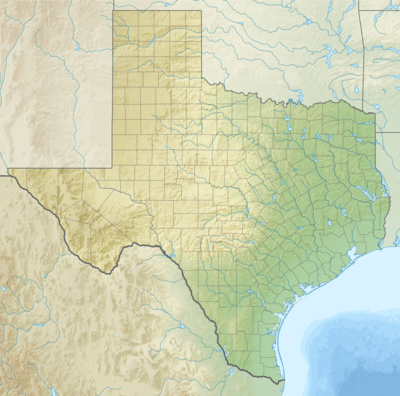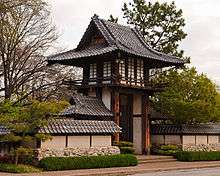Fort Worth Botanic Garden
|
Fort Worth Botanic Garden | |
|
Botanic Garden in 2012 | |
 Fort Worth Botanic Garden  Fort Worth Botanic Garden | |
| Location | 3220 Botanic Garden Blvd., Fort Worth, Texas |
|---|---|
| Coordinates | 32°44′18″N 97°21′42″W / 32.73833°N 97.36167°WCoordinates: 32°44′18″N 97°21′42″W / 32.73833°N 97.36167°W |
| Area | 33 acres (13 ha) |
| Built | 1929 |
| Architect | Hare & Hare et al. |
| Architectural style | Renaissance |
| Website | Fort Worth Botanic Garden |
| NRHP reference # | 08001400[1] |
| Added to NRHP | January 29, 2009 |

Entrance to Japanese Gardens
The Fort Worth Botanic Garden (109 acres) is a botanical garden located at 3220 Botanic Garden Boulevard, Fort Worth, Texas. The garden was established in 1934 and is the oldest botanic garden in Texas, with 2,501 species of native and exotic plants in its 21 specialty gardens. It is open daily. An admission fee is charged for the Conservatory and Japanese Garden; the other gardens are free.
Features
In addition to wooded areas, major garden features include:
- Back Yard Vegetable Garden - Vegetable garden that hosts many educational programs.
- Conservatory (10,000 square feet) - tropical displays of orchids, bromeliads, and trees.
- Four Seasons Garden - Hundreds of iris, daylily, and chrysanthemum varieties.
- Fragrance Garden - small garden build for the seeing impaired with fragrant plants and fountain.
- Fuller Garden - pathways and lawn; site for weddings and garden parties.
- Japanese Garden (7 acres; established 1973) - the Fort Worth Japanese Garden, with three koi ponds, waterfalls, bridges, teahouse, pagodas, pavilions, zen garden, cherry trees, and Japanese maples.
- Lower Rose Garden - rose garden inspired by Villa Lante (Italy).
- Native Texas Boardwalk - A raised path through the trees with educational information along the way.
- Oval Rose Garden - hundreds of roses; renovated 2002.
- Perennial Garden - perennials with culinary herb collection, as well as ponds and small waterfall.
- Rock Springs - Elevated pathways, and bridges over ponds and streams.
- Trial Garden - evaluation site for hundreds of species of perennials.
- Water Conservation Garden - demonstration xeriscape garden.
- Water Wise Entrance - entry garden with agave, Texas sage, salvia greggii, Mexican Bush sage, red yucca and Esparanza.
The garden also contains a Begonia Species Bank, established and operated to prevent the loss of begonia species, it is the largest begonia collection in the United States.
Photo gallery
 Garden landscaping, 2011
Garden landscaping, 2011
See also
References
- ↑ National Park Service (2013-11-02). "National Register Information System". National Register of Historic Places. National Park Service.
External links
| Wikimedia Commons has media related to Fort Worth Botanic Garden. |
This article is issued from
Wikipedia.
The text is licensed under Creative Commons - Attribution - Sharealike.
Additional terms may apply for the media files.

